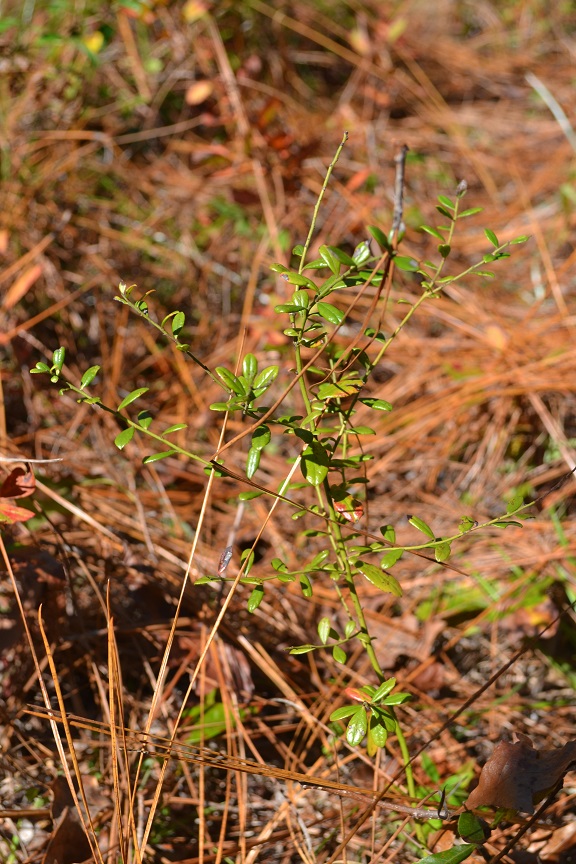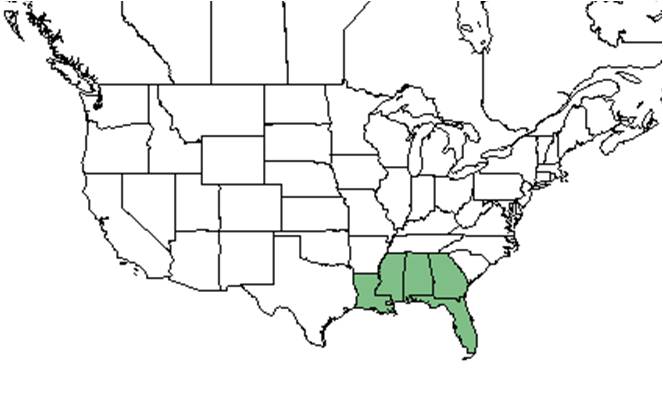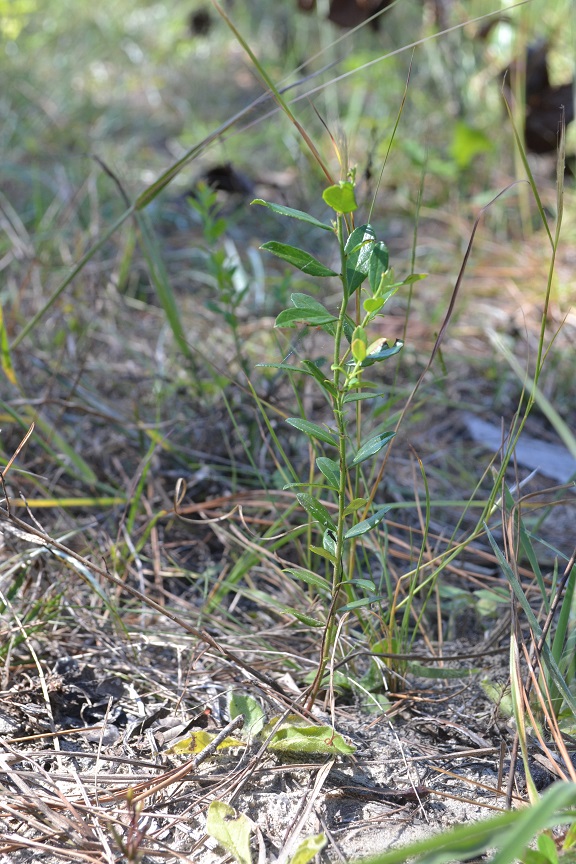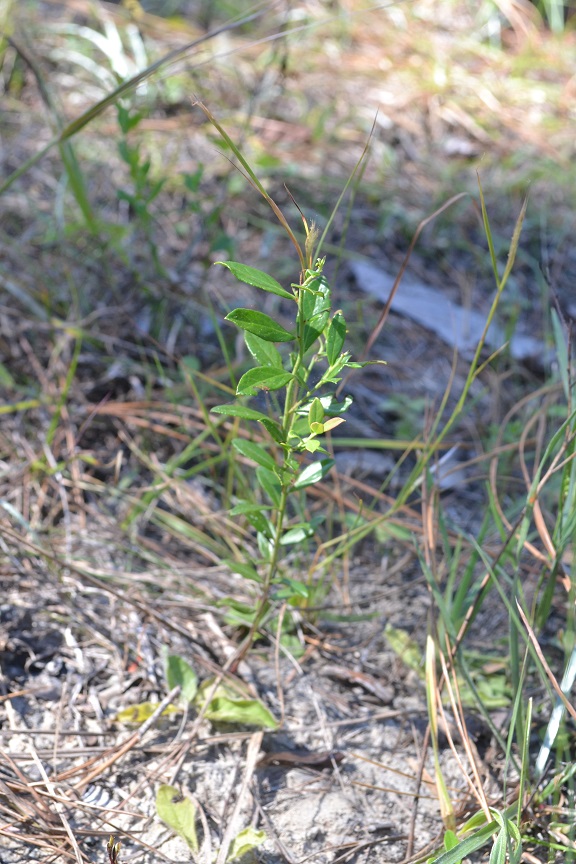Difference between revisions of "Vaccinium darrowii"
| Line 32: | Line 32: | ||
===Habitat=== <!--Natural communities, human disturbed habitats, topography, hydrology, soils, light, fire regime requirements for removal of competition, etc.--> | ===Habitat=== <!--Natural communities, human disturbed habitats, topography, hydrology, soils, light, fire regime requirements for removal of competition, etc.--> | ||
| − | ''V. darrowii'' has been found in pond margins, prairies, pine woods, evergreen shrub bogs, titi swamps, cabbage palm hammocks, wiregrass sand ridges, scrub oak sand ridges, turkey oak-persimmon scrub, and pine flatwoods.<ref name="FSU"> Florida State University Herbarium Database. URL: http://herbarium.bio.fsu.edu. Last accessed: June 2021. Collectors: Loran C. Anderson, G. R. Cooley, Robert K. Godfrey, Robert Kral, Sidney McDaniel, Joseph Monachino, J D Ray, and George M. Riegler. States and counties: Florida: Franklin, Gadsden, Hernando, Jackson, Lafayette, Pasco, Sarasota, Seminole, Wakulla, and Walton.</ref> It is also found in disturbed areas like the edges of disturbed pine flatwoods.<ref name="FSU"/> Associated species: ''Gaulussaces, Vaccinium, Myrica, V. stamineum, Serenoa repens'', and ''Lyonia lucida''.<ref name="FSU"/> | + | ''V. darrowii'' has been found in pond margins, prairies, pine woods, evergreen shrub bogs, titi swamps, cabbage palm hammocks, wiregrass sand ridges, scrub oak sand ridges, turkey oak-persimmon scrub, and pine flatwoods.<ref name="FSU"> Florida State University Herbarium Database. URL: http://herbarium.bio.fsu.edu. Last accessed: June 2021. Collectors: Loran C. Anderson, G. R. Cooley, Robert K. Godfrey, Robert Kral, Sidney McDaniel, Joseph Monachino, J D Ray, and George M. Riegler. States and counties: Florida: Franklin, Gadsden, Hernando, Jackson, Lafayette, Pasco, Sarasota, Seminole, Wakulla, and Walton.</ref> It is also found in disturbed areas like the edges of disturbed pine flatwoods.<ref name="FSU"/> |
| + | |||
| + | Associated species: ''Gaulussaces, Vaccinium, Myrica, V. stamineum, Serenoa repens'', and ''Lyonia lucida''.<ref name="FSU"/> | ||
===Phenology=== <!--Timing off flowering, fruiting, seed dispersal, and environmental triggers. Cite PanFlora website if appropriate: http://www.gilnelson.com/PanFlora/ --> | ===Phenology=== <!--Timing off flowering, fruiting, seed dispersal, and environmental triggers. Cite PanFlora website if appropriate: http://www.gilnelson.com/PanFlora/ --> | ||
Revision as of 17:56, 21 June 2021
| Vaccinium darrowii | |
|---|---|

| |
| Photo by Kevin Robertson | |
| Scientific classification | |
| Kingdom: | Plantae |
| Division: | Magnoliophyta - Flowering plants |
| Class: | Magnoliopsida – Dicotyledons |
| Order: | Ericales |
| Family: | Ericaceae |
| Genus: | Vaccinium |
| Species: | V. darrowii |
| Binomial name | |
| Vaccinium darrowii Camp | |

| |
| Natural range of Vaccinium darrowii from USDA NRCS Plants Database. | |
Common name: Darrow's blueberry
Contents
Taxonomic notes
Synonym: V. darrowi.[1]
Varieties: Cyanococcus myrsinites (Lamarck) Small var. glaucum A. Gray.[2]
Description
A description of Vaccinium darrowii is provided in The Flora of North America.
Distribution
Ecology
Habitat
V. darrowii has been found in pond margins, prairies, pine woods, evergreen shrub bogs, titi swamps, cabbage palm hammocks, wiregrass sand ridges, scrub oak sand ridges, turkey oak-persimmon scrub, and pine flatwoods.[3] It is also found in disturbed areas like the edges of disturbed pine flatwoods.[3]
Associated species: Gaulussaces, Vaccinium, Myrica, V. stamineum, Serenoa repens, and Lyonia lucida.[3]
Phenology
V. darrowii has been observed flowering from February to April and in December.[4]
Seed dispersal
This species is thought to be dispersed by consumption by vertebrates.[5]
Pollination
The following Hymenoptera families and species were observed visiting flowers of Vaccinium darrowii at Archbold Biological Station:[6]
Apidae: Apis mellifera, Epeolus erigeronis, Habropoda laboriosa
Halictidae: Agapostemon splendens, Augochlora pura, Augochlorella aurata, A. gratiosa, Augochloropsis anonyma
Megachilidae: Megachile brevis pseudobrevis
Vespidae: Eumenes smithii
Conservation, cultivation, and restoration
Cultural use
Vaccinium darrowii produces a berry that can be eaten raw or cooked into goods such as jellies or pies.[7]
Photo Gallery
References and notes
- ↑ Weakley, A.S. 2015. Flora of the southern and mid-atlantic states. Working Draf of 21 May 2015. University of North Carolina at Chapel Hill, Chapel Hill, North Carolina.
- ↑ Weakley, A.S. 2015. Flora of the southern and mid-atlantic states. Working Draf of 21 May 2015. University of North Carolina at Chapel Hill, Chapel Hill, North Carolina.
- ↑ 3.0 3.1 3.2 Florida State University Herbarium Database. URL: http://herbarium.bio.fsu.edu. Last accessed: June 2021. Collectors: Loran C. Anderson, G. R. Cooley, Robert K. Godfrey, Robert Kral, Sidney McDaniel, Joseph Monachino, J D Ray, and George M. Riegler. States and counties: Florida: Franklin, Gadsden, Hernando, Jackson, Lafayette, Pasco, Sarasota, Seminole, Wakulla, and Walton.
- ↑ Nelson, G. PanFlora: Plant data for the eastern United States with emphasis on the Southeastern Coastal Plains, Florida, and the Florida Panhandle. www.gilnelson.com/PanFlora/ Accessed: 14 DEC 2016
- ↑ Kirkman, L. Katherine. Unpublished database of seed dispersal mode of plants found in Coastal Plain longleaf pine-grasslands of the Jones Ecological Research Center, Georgia.
- ↑ Deyrup, M.A. and N.D. 2015. Database of observations of Hymenoptera visitations to flowers of plants on Archbold Biological Station, Florida, USA.
- ↑ Hardin, J.W., Arena, J.M. 1969. Human Poisoning from Native and Cultivated Plants. Duke University Press, Durham, North Carolina.

